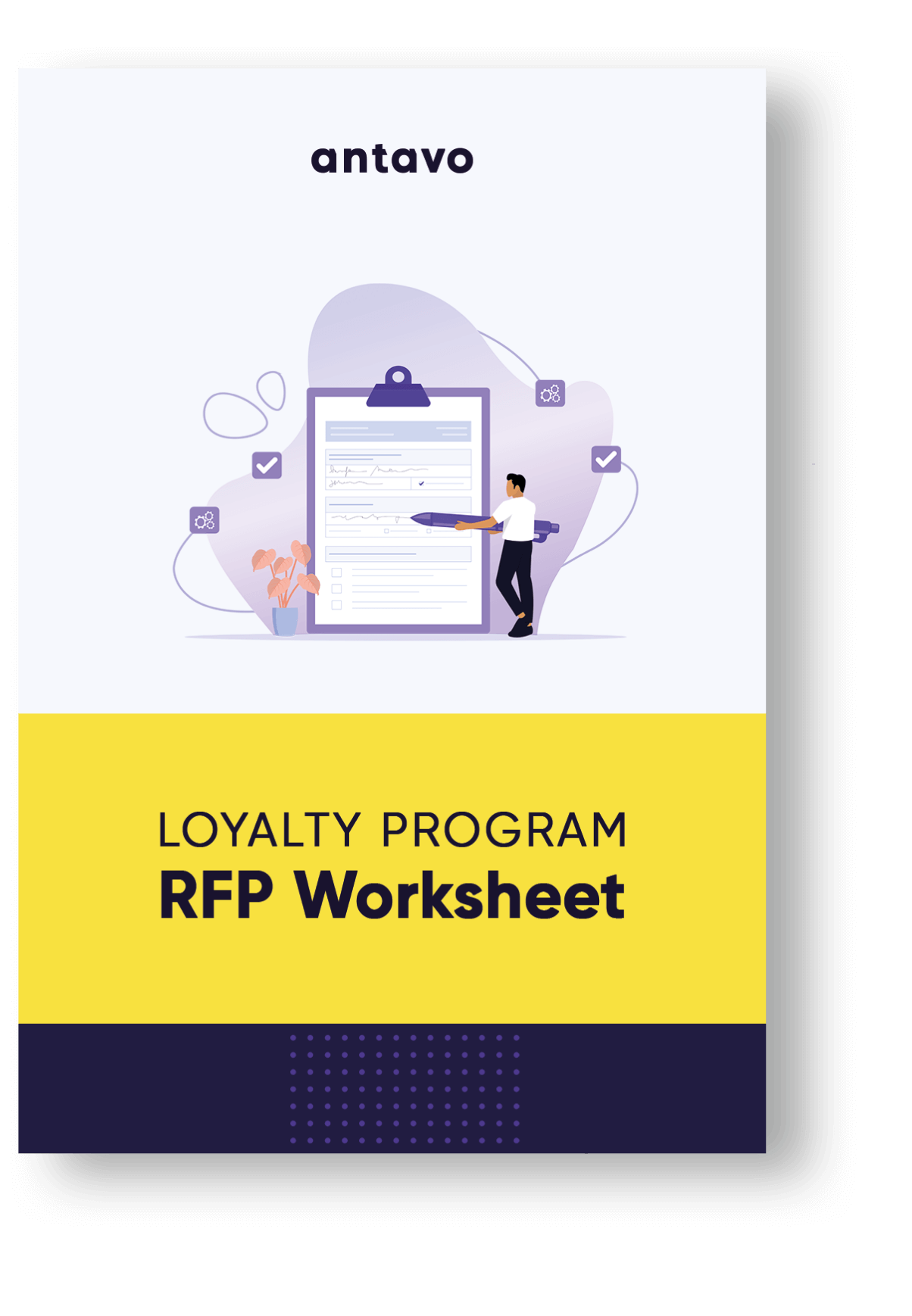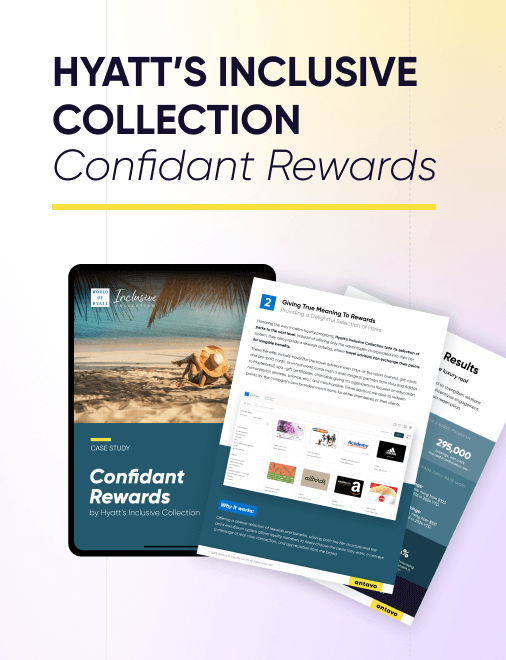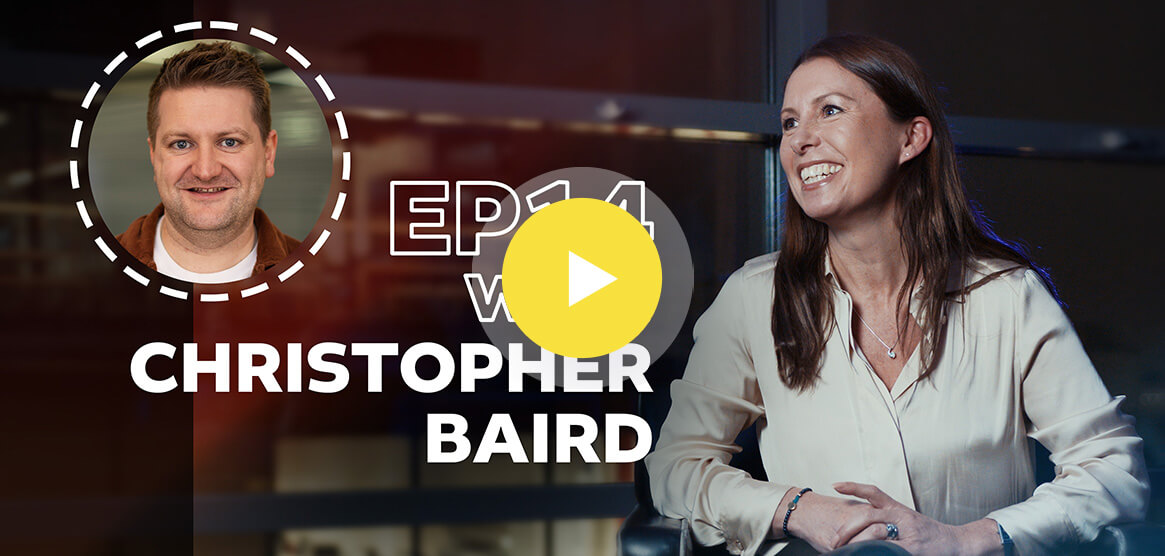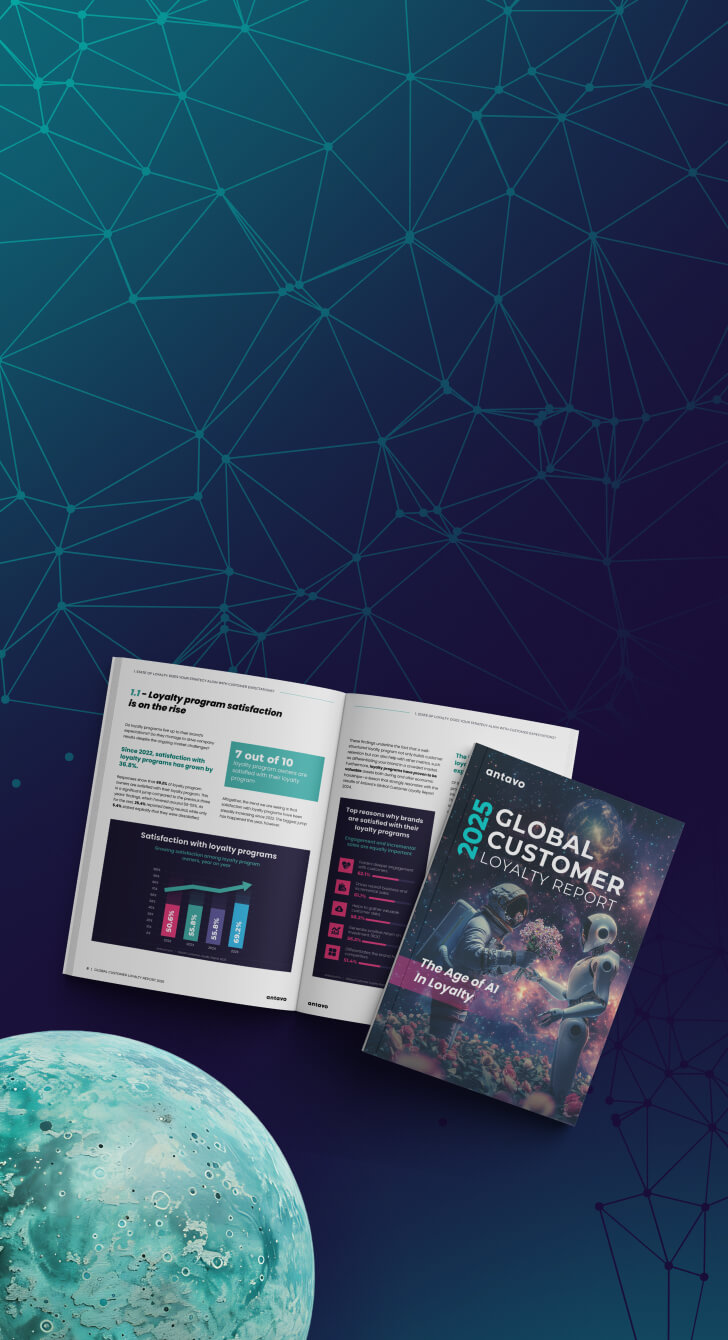On the fourteenth episode of the Loyalty Stories podcast, we are joined by Christopher Baird, Director at frog, which is part of Capgemini Invent.
The interview for this podcast has been a valuable source for Antavo’s Global Customer Loyalty Report 2024. Make sure to download it for over 30 statistics on loyalty program trends.
In today’s episode, we examine loyalty programs from Christopher’s perspective. He highlights the Rituals loyalty program as a favorite and explains why finding the perfect balance between offering real value and gently encouraging spend is the key to success. We talk about recent changes in the industry, and which decision-makers are currently involved in the loyalty program launch.
Highlights from our conversation with Christopher:
- How do different regions view loyalty programs, and what are the biggest differences
- Why loyalty programs are viewed as major data sources
- Trends, like going from static to flexible mechanisms
- What young professionals should do to get a 360-degree view of the loyalty industry
Learn more:
- LinkedIn profile of Christopher Baird
- The frog website
- Take a closer look at the Element of Surprise and Delight in Loyalty Programs
- Book a demo with Antavo’s loyalty experts
Michelle
Hi, welcome to Antavo Loyalty Stories, Antavo’s Podcast on customer loyalty and loyalty programs. I’m Michelle Ellicott-Taylor and I head up the Global Partnership Team at Antavo. We’re a technology vendor that powers loyalty programs all over the world. And we work with a number of brands and great businesses, including KFC, Benefit Cosmetics to name a few. We’re running Antavo loyalty stories to give more insights into customer trends in loyalty and to get to speak with experts in this field.
And today’s guest is Christopher Baird from frog, part of Capgemini. Chris, thank you very much for joining today’s session.
Chris
Yes, thank you for having me.
Michelle
It’s great to have you here. It would actually be really nice if you could just give us a bit more of a background on yourself and also about frog and being part of Capgemini.
Chris
Yep, yep, definitely. So I’m a director with frog, which is part of Capgemini Invent based out of London. frog is Capgemini’s creative consultancy, where we’re not quite a traditional marketing and ad agency, but we’re not a full-on consultancy. So we blend strategy, design, innovation, tech and data, but we have the power of Capgemini to then work at a global scale with organizations that are both small as well as the enterprise level.
I look after a team of customer experience practitioners and I also head up the work that we do globally around loyalty and membership and we’ve done a lot of different work with retailers, with financial service organizations and other organizations on their membership and loyalty transformations. So it’s very exciting to be here to talk to you today.
Michelle
Oh no, that’s great. Obviously you’re going to be sharing lots of very insightful information with us based on that experience. So I think what’s always a great way to get this started and talking with someone like yourself is sharing with the audience, someone that’s done it really well for you in loyalty. Like what is your favourite loyalty program and why is that?
Chris
Yeah, so I’ve got a couple of examples that spring to mind. The one, if I kind of have to pick one, is one that I don’t see reported on too much. And it’s actually Rituals, which is the kind of health home and beauty brand. For me, I think it has a really nice blend of features. It balances the kind of transactional side of things that consumers want, but it also has some really nice emotional storytelling.
There’s elements around surprise and delight, and quite importantly, but something which gets forgotten about, I think, sometimes is that the digital experience is pretty slick. So from a customer perspective, it all just works really well.
It doesn’t feel as if they’re trying to force things on you too much, they’re not trying to sell too hard, but actually from a business angle, they are actually very good at those gentle nudges to get to that next level. Or if you add something else into your basket, you can get a slightly better gift for free.
So from a customer perspective, you get that sense of value, even though you are spending a little bit more without it feeling like too much pressure on you.
Another example which comes to mind is in the travel aid industry with Norwegian Air. Again, a slightly smaller organization to a lot of the frequent flyer programs that we hear about. What I like about them is, as well as again having that kind of core kind of points that you can spend on future flights, they also offer a lot of benefits which are really targeted at customer pain points.
So the things that typically people would get frustrated by or annoyed by, which could be about your luggage allowance, it might be around the speed of check-in and fast track, and so on. And you get to choose something that is relevant to you, which can, you know, depend on the airport that you’re maybe flying on, the amount of luggage you would need to take and you can kind of tailor the value you get depending on where you’re going and what you want that experience to look like. But I actually think there’s brands that, you know, don’t have a program that I’m actually quite loyal to as well.
So from a clothing perspective, brands like Patagonia and Passenger, don’t have any program per se, but the way in which they show up for customers, the values that they exhibit are things that make me want to be a customer of theirs. So it’s not just loyalty programs, but also kind of the way in which brands exist that can make someone like me loyal to them.
Michelle
That’s really interesting actually with the last two that you mentioned, because thinking just about things like sustainability and ESD and I guess the emotional loyalty. So it isn’t necessarily that full loyalty program someone’s got, but how they’re treating a customer, like you’re saying here, creates that loyalty.
Chris
I think there’s a really interesting challenge that people working within loyalty have, which is around not just creating consumption for consumption’s sake, but actually thinking about what are the right ways for customers to engage that they still get value from, and that may involve free gifts or buying another item, but doing so in a slightly more thoughtful and conscious way.
Michelle
Yeah, I think that’s really important, like we’ve said before in today’s world, thinking about these wider things in the pure purchase and encouraging that transaction. So with that in mind, what have you seen that have been like key changes in how people are approaching their loyalty programmes in recent years?
Chris
So what we’ve seen, certainly a few years ago, there was a lot of noise around, it can’t all just be about the transaction, it needs to be around experiences. And what we saw was some organizations moving entirely into experiences. There was very little rational value from some of their offerings, which confused customers.
So, you know, let’s say they did have a loyalty card, customers would be swiping at the till or they’d be logging in expecting to get some sort of immediate value of some transactional sense. And they weren’t and they were getting confused. They didn’t understand how the program would work and they would abandon.
And what I think we’re now seeing much more of is organizations blending those two things. So they realize we still have to have that core baseline transactional element. We need to give immediate value to the customer, which could be in the case of points. It could be cash back. It could be money off at the till, for example.
But on top of that, layering in new experiences, the slightly more softer side of things, more engaging experiences. And I think that will continue to evolve as organizations try to figure out what is the right blend of experiences that we want to deliver in order to drive loyalty as an outcome. Many of those things will form within a club or a program.
But I think what we’ll also see is rather than those programs being tacked onto the side, you know, as a thing that you join, they will become much more intrinsically linked to the overall experience. So the way in which a customer interacts with a brand will be through membership and through those interactions, that will drive the loyalty.
So I think we’ll see big shifts there from kind of loyalty to membership. I also think that the level of sponsorship that we’re seeing from organizations with regards to loyalty is changing. It’s not just the head of department, the head of loyalty that is now interested in this. We are seeing chief customer officers, chief marketing officers, and chief executive officers as well being really interested in how loyalty and loyalty experiences can be used as a driver for sustainable growth.
It’s a way of deepening the relationship with the consumer. And it is no longer just a marketing activity that sits on the side. It is something that can be a very major catalyst for change within an organization. And as a result, it’s getting a lot more attention from the C-suite.
Michelle
Yeah, that’s really interesting. I was actually going to ask you about that later on. So kind of touched on that now. But yeah, seeing how it’s moved away maybe from being, I guess, purely sitting with the CMO, who’s obviously very important in these decisions with loyalty, but it’s the wider business and executive level interest in the loyalty programs.
Chris
Yeah, exactly. And I think as things like cookies start to change, the way that people and organizations do marketing will need to change. And I think loyalty will also become a much more important part of that, as a place to gather first-party data about customers and consumers, which might replace existing sources of data, which in a few years may cease to exist because of regulation and advancements in technology, consumer demands on privacy.
Michelle
Exactly, and I guess with that in mind, thinking about, like we’ve looked at some of the changes that have happened there in the industry, but maybe like with key trends, is there something that you see, you know, over the next 12 months that is going to be, maybe one or two key trends that the loyalty industry will be adopting?
Chris
So I think sort of in line with that shift to membership versus kind of loyalty as we’ve traditionally known it. I think the idea around whatever that offering might be, if it is a program, being much more adaptive to the changing business, the changing market, customers changing demands, rather than it’s a fixed program with, has five to 10 features that exist for everybody, and that’s a fairly static thing.
I think membership will allow the experience and the interaction points that customers have with an organization to change and to move with it. It should give customers much more choice and control over the way in which they’re rewarded and the value that they can extract from that relationship.
And it should also be a way, that as organizations perhaps look to differentiate, they might move into different verticals, create new business ventures. Membership can be used as a way of creating an entirely new customer base for that new product, that new service. It’s a group of highly motivated, highly interested people that you can test things with if it’s perhaps something a little bit more out there that you’re not quite ready to release to the masses.
And so, you know, membership, as I say, will become this slightly amorphous thing rather than just a database of customers that sits on the side that we send some marketing content to on a weekly basis.
Michelle
Yeah, I think the word membership is coming up a lot and obviously associated to loyalty, but it’s not, I guess, thinking of it as loyalty, just being pure, like an earn and burn program. It’s the bigger picture of the membership and how you’re treating these people and within that membership group, there may be multiple groups like your VIP group or certain product interests, things like that across the brand.
Chris
Yeah. And I think something that, that we often discuss with many of the clients that we work with and, you know, we’ve, we’ve debated it internally ourselves, membership and the notion of like subscriptions and, you know, Amazon Prime as an example, is that a loyalty program, it drives loyalty in the sense that it drives repeat purchase and frequency.
And I do think that we will see, in increase in brands exploring that as a, as a channel, it’s certainly a way to create new revenue streams from customers. And there’s definitely some value there for most organizations where you can offer a paid for service in return for extra value.
But I think that the more wholesale change that we will see is a slightly different lens to membership that doesn’t necessarily have to be gated or paid for. You can still have open membership, that kind of acts as a one point of entry into an organization and all that it might have to offer, whether that’s products, services, a partnership ecosystem, et cetera.
But I do think that there will be confusion over membership and subscriptions and loyalty. And that’s something that, from a business strategy standpoint, organizations really need to be clear on, on whether we’re doing something to drive loyalty, or it’s a new service which is paid for which will drive repeat visits and drives the similar outcomes to what a traditional loyalty program might do but isn’t necessarily part of, in my view at least, loyalty activities.
Michelle
Yeah, exactly. You’ve got your standard loyalty programs, but then there is other ways that people are engaging with a brand that is actually creating the loyalty. So while it might not be a strict loyalty program, in fact, it’s doing exactly that job. So yeah, it’s gonna be interesting to see how those different memberships and things evolve.
And I wanted to ask you as well, like when you’re talking with your, I guess, the brands and your customers, and you’re thinking about all these ideas and the strategy, there’s obviously the platforms that have to deliver on this.
What’s, you know, as a consultant, what’s front of mind for you there? Are you thinking about the latest innovation that’s coming with that product? Are you thinking about, you know, are you seeing the roadmap for that platform over the next 12, 18 months? Is it about the integration implementation, ease of use? What are the things that are, you know, real considerations there?
Chris
So for me, and I’m not a technologist by heart, so I maybe have a different opinion to some others, but whenever we’re working with an organization, we’re trying to resolve a problem, we don’t start with the technology. We look at the customer needs, we look at where there may be pain points that they’re experiencing, we look at the outcomes that the business wants to try and achieve, and we work with them, we collaborate to understand what things we could do to address that.
In a lot of cases, that then does require some technology enablement to make it happen, whether that’s front end experiences that the consumers will actually interact through, or the kind of the back end power that you need to actually enable the data to exist and for all of those interactions to take part.
So what I would say is, I think in the same way that I think organizations need to set up membership as something which can be flexible and adaptable and can change as the world around it changes. I think technology and vendors who have platforms in that space also need to be able to operate in that same manner.
There are a lot of large scale enterprise solutions which have the reputation of being quite heavy and bloated because they’ve tried to implement every feature under the sun in order to fit every possible scenario, and they end up not working for the majority of scenarios.
So I think tech technology vendors and platforms who do, yes, you know, stay ahead of the curve when it comes to trends are able to look ahead, predict where, you know, loyalty might go and to be able to create a feature set that will address to that. But who can also, you know, pivot at a point where maybe something else comes in that wasn’t predicted, that can integrate well enough with other core platforms that an organization might have. And that can evolve itself, I think, is something that will be hugely advantageous to organizations who are looking for a loyalty tech platform.
Michelle
Yeah, exactly, because the whole program is going to be evolving and adapting, isn’t it? And they’ll be making changes and it can’t be a static platform. And that’s it. You’ve bought something and that’s how it’s going to look for the next 12 months. It has to keep changing as the as the brand’s needs and requirements change too. Excellent.
Chris
Yeah, exactly. And I think just to add, I think often there will be, it should be a partnership where there may be elements in a technology roadmap that a retailer, let’s say, does actually want to bring into the experiences that it offers to customers, in which case there may be some tech-led innovations.
And other times, it may be that the organization wants to drive change in a particular way, and they then need the technology to shape itself around that need. But I expect there will be this kind of two-way partnership between organizations and the vendors that they partner with for technology.
Michelle
Exactly, that’s going to be needed there. I’m just thinking about the, I guess, the landscape that frog are working with from a global perspective. Do you see that there are differences in regions that are, how they respond to loyalty programs, or is it one type that’s more prevalent in one region versus another, or is it the flip of that, that there’s commonalities across the globe?
Chris
I would say there definitely are differences. I think within Europe, there are generally quite a lot of similarities. The offerings that organisations have tend to be quite consistent. So that’s largely the perspective that I have and which I’ve been talking about where we’ve seen that shift to more experiential, more emotional engagement coupled with the more transactional, rational value.
I think in North America, they haven’t moved as much as Europe has towards that emotional engagement that we’ve seen. There is still a lot of focus on the more traditional sides of loyalty, whether that’s coupons, rewards, immediate discounts, 5% across the entire product range you get when you shop. They’re slowly, I think, moving in that direction, but I would say that they have stuck a lot more in that kind of more traditional description of what loyalty means over in North America.
And then out in East Asia, I would say because they have digital experiences much more integrated with society. So, you know, the super apps that they quite often will use as a one-stop shop for everything that they do. They’re much more expecting fantastic digital experiences that probably when you look to Western Europe, we haven’t even got ourselves, we’re still trying to connect things together.
And I think coming with that, the sharing of data, data privacy, et cetera, also has a slightly different feel to it. So, you know, there was a story about a coffee chain where customers could essentially pay for their cup of coffee with their data. So there was no cash exchanged. It was all by agreeing to give up certain data, to the coffee shop that then I assume would be sold on for marketing purposes. That is what you’re paying with in order to get your coffee.
So there’s a very different, and that’s not to say that everybody in, in those countries would be happy to do that, but there’s a slightly different expectation or, feeling towards that data exchange than probably we have in, in Europe and North America as well.
Michelle
Yeah, I think there’s obviously certain adoptions of loyalty that are apparent in certain regions, but it’s good for a brand to be conscious of if they are a global brand, what’s going to work for them in one region might not necessarily resonate with a customer base in another. So it’s good for them to, I guess, you know, have that good knowledge of each region they’re working with and what’s going to be the right program to put in.
Chris
Yeah, absolutely. And, you know, we’ve worked with different global brands that have had that exact challenge. And the way that we’ve tried to approach it is to work with them to create a global framework. So the same principles are that exist across all of the countries in terms of how we want the loyalty offering to be governed, the things that we want it to do for customers and the value that we want to give to customers. But then there are localizations on how that actually, and, you know, it exists within the different channels, then needs to change.
And that might be true even within Europe from a regulatory standpoint. But having that kind of global framework helps make sure that there is consistency country to country, you know, similar branding, similar language that’s used in terms of how it’s communicated. But the mechanics may then differ in different localities.
Michelle
Great, okay. And thanks for the insight on that. And I actually was just thinking about something you shared earlier in regards to the, I guess, the business leaders who are giving you the assignments and who’s involved with these types of the loyalty campaigns, and whether it’s the CMO, the CEO, etc.
But what about someone who’s kind of coming into loyalty at a newer place? So someone who’s 25, they’ve been working in junior loyalty manager position for some time. And I guess they’re inspired, to lead that team, what would be the kind of advice you would be giving them to succeed in that growth in that role?
Chris
I would say that someone in that capacity needs to partner with other parts of the organization. It isn’t just about marketing. There are so many different aspects of business which drive loyalty. You can have the best scheme in the world, the best marketing. But for example, if your customer service operations are dreadful, then that’s going to be an immediate break in the customer experience and no number of points or coupons that you get, is going to keep someone coming back to you if your customer service is dreadful.
Similarly, if let’s say you’re a retailer and you’ve got a store experience, which is messy, just doesn’t give that nice inviting feeling for you to go in. I’m not going to go there. I’m going to vote with my feet and I’m going to find another retailer where I do like the experience in store.
And if you’re only focusing within the traditional realm of loyalty, and I think this is why I keep, keep talking about the fact that I think loyalty as a kind of a definition will change from just the program to the collection of experiences that customers have with an organization.
If you’re a loyalty expert working only in the marketing world and only really thinking about it as a program, you will be hindered by the other experiences that customers are having in other areas. And so as kind of individual business functions, I think they need to work more closely together, understand how their collective power ultimately drives the loyalty that an organisation would be looking for.
Michelle
Well, thanks for sharing that insight. Hopefully that’s going to help some of our listeners with where they’re looking to grow with their careers. So you shared so much with us today. Thank you so much. Really enjoyed the session. I know you kindly shared at the beginning an overview of some of the brands that have made an impact on you. And I really liked the Rituals stories. So I need to go back and check that one out for myself.
But outside of that and what you’ve already shared, what’s something, I guess, as a final point surprised you in the loyalty space, whether that’s a great surprise or something that you just didn’t expect. Or, yeah, is that is there something that kind of comes to mind there?
Chris
I think having worked in loyalty for quite a few years now, I think the variety of things which touch on loyalty probably has surprised me over time that, you know, when I first started working in it, I was very much kind of what I was referring to there, someone who really thought of it as it’s a scheme, it’s a program that has these fixed defined features and, you know, that’s all that matters.
And if we get those right, and, you know, we can, we can have loyalty, all of our customers will be, will be loyal to us. And that’s absolutely not true. And, but the more that I’ve worked with different organizations, the more you realize that it’s, it’s about so much more than that. And it’s not just even like the customer functions within an organization that are important.
It’s also more of the, the support functions around like, business, IT, financial services, legal, and how, you know, the employee experience enables the better customer experience. So how can HR functions support store workers or branch workers or even people in head office to do their jobs more effectively, to have the tools at their disposal to be able to deliver a better experience for the customers, which then obviously has a knock on effect on the customers loyalty to the organization.
So there’s just so much more to it than just, you know, a loyalty marketing activity, which sits as one pillar within a marketing function. And certainly when I got into loyalty, that was quite a big surprise. And the more that I work with brands and the larger the organizations and the more complex the organizations, there are more and more parts of those organizations that get added into the conversations, who are interested in finding out how they can be part of the loyalty activities because they see benefit in their jobs and they feel that they can support.
And yeah, no matter what organization I work with, there’s always something new or some other part of the business that wants to get involved, which is very exciting. It’s great that so many different people are interested and want to be part of it. That’s been quite surprising.
Michelle
Yeah, I think that’s a really nice point to end on because I think it’s been a theme through all of this session that it’s, loyalty has not sat on its own, it’s not that one loyalty program that you’re putting in, it’s a much bigger piece across the whole business. So yeah, thank you.
It’s been great to have you on today. And frog obviously are part of the headline key partners within the Global Loyalty Report. So we’re really excited that you’ve taken part in this and we can’t wait to be able to share all these insights with the customers. So thanks again for joining Christopher.
Chris
You’re very welcome. Yeah, super exciting. And I look forward to seeing all of the insights that you’re able to create from the experience.
Michelle
Excellent and thanks everybody for joining this session. Wherever you’ve listened to this or watched this please give us a like and also if you’ve got any questions on consultancy in regards to loyalty please head across to frog’s website frog.co visit them reach out to Christopher and they will be able to help you and please visit antavo.com for further information about our loyalty platform.
Thanks again for listening!










